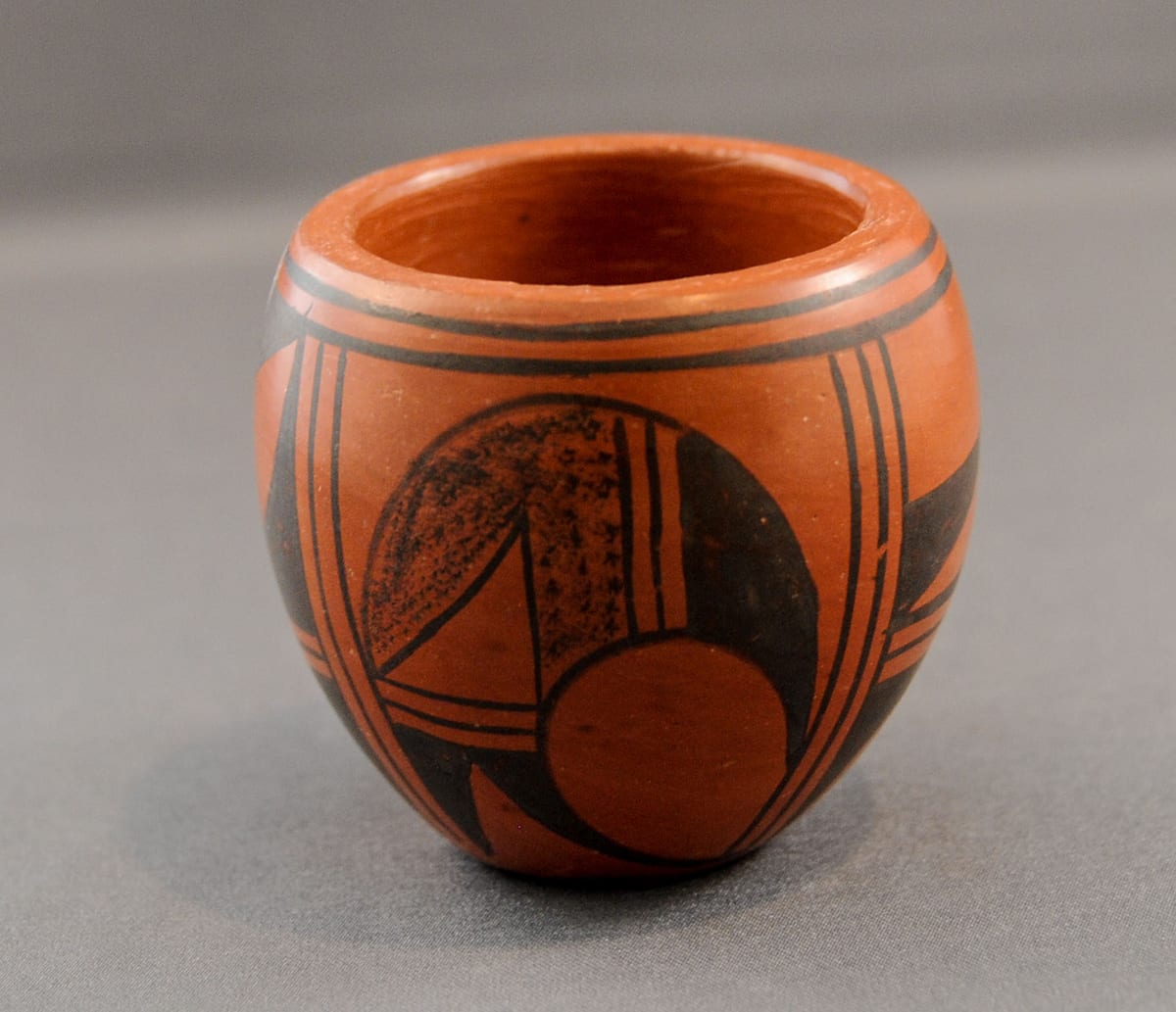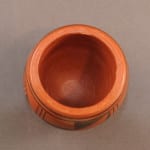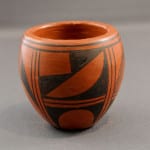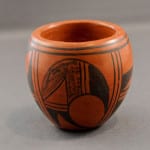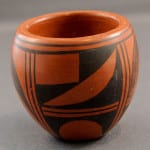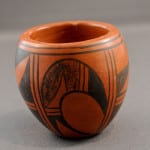This miniature red clay jar sits on a small 0.875” base, expands to a wider waist, and then narrows slightly to a 2.0” mouth, which gives the pot a sense of lightness and upward thrust. The walls are even and relatively thick for the jar’s size; the pot is polished almost to its base on the interior. The exterior is divided into four panels of design: one pair has avian elements and one pair has geometric elements.
It’s an attractive little piece, but it is not exceptional. The potter is not particularly well known; her name is misspelled in a standard reference book (Schaaf 1998:75). Nevertheless, we know a good deal about Vivian Muchvo and her family because of a friendship between her parents (Ethel and Wilfred Muchvo) and an Anglo family from Massachusetts (Maud and Carey Melville).
The Melvilles visited Hopi in 1927 as part of an 18,000-mile motoring trip around the United States—a massive drive before the days of interstate highways. More extraordinary was the friendship that grew between Ethel Muchvo and Maud Melville. During the decade following their initial meeting, the two women exchanged a series of letters. Many of those that traveled east (Ethel to Maud) survived and became the basis of a book, Hopi Summer (Davis 2007). The exchange offers a rare insight into the lives of two bright women, one trying to survive a very harsh and difficult time on the reservation, one living a relatively affluent life in the east, both trying to make connection across a gulf of culture and paternalism.
Most striking to me was the harshness of life at Hopi. Without a history of natural inoculation, Anglo diseases ravaged the reservation. Smallpox epidemics had killed a majority of the Hopi people by the end of the 19th century (Rushforth and Upham 1992: 68-122); in the 1930s, tuberculosis and spinal meningitis seems to have been the major killers. Traditional Hopi economy is agricultural. Sufficient rain to grow crops is always problematic, but during the decade of the 1930s, agriculture became particularly difficult as the reservation experienced the same drought (punctuated by sudden floods) that inflicted much of the rest of the country. When Ethel and Maude first met, the reservation was in transition between a purely agricultural economy and a system that depended on cash exchange with the outside world. During the 1930s, outside interest in commerce with the reservation evaporated as tourists stopped coming to Hopi and the market for Hopi crafts dried up with the rain. Though crops are difficult, Christian missionaries had long viewed the Hopi and Hopi-Tewa as fertile ground for conversion. Such conversion was undertaken with extreme bias. Davis (2007:78, 108) describes Abigail Johnson, a missionary operating at First Mesa during the time of the Ethel/Maude friendship, as “having an intense dislike for the Hopi kachina ceremonies…She regarded the Hopis without Christianity as living in darkness and sin.” (Johnson’s own evaluation of the Hopi can be found in her autobiography, 1933). Missionary activity undercut cultural patterns that helped the Hopi survive. All of these negative trends converged on the Muchvo family (and many others) and made life difficult, often impossible. “We have a big sorrow over us,” a Hopi wrote of the times (Davis 2007:108).
During her lifetime, Ethel had several miscarriages and 12 live-born children. Her first 11 full-term children died of disease. Vivian, the maker of pot 2012-09, was the only child to live to become an adult and was the central joy of her mother’s life. Davis (2007:8) is able to reproduce the letter from Ethel to Maude announcing Vivian’s birth on August 9, 1931. The letter contains a request for a baby bottle and nipples “because she (Ethel) did not think that she would be able to nurse their baby ‘because I also have harde time for milk.’ It is not unlikely that Ethel and Wilfred were literally on the verge of starving,” writes Davis. “They had no crops, no corn, Wilfred was very ill (from tuberculosis), and if Ethel had little to eat, naturally she would not be able to provide much nourishment for her baby. Ethel’s letter was a desperate plea for help to her friend” (2007:119). Later, there are photographs of the child—as if Ethel wanted proof that her young daughter was still growing (2007:124, 143, and 144). By 1936, when Vivian was only 5, her mother was teaching her to make pottery (Davis 2007:139). By 1938, Ethel was going blind and could no longer write to her Massachusetts friend nor make her own pottery. In June 1942, Wilfred died of tuberculosis. Ethel died nearly 30 years later, on February 22, 1970 (2007: 145, 147, and 152). Ethel “wanted to stay on the earth to be with her daughter Vivian,” Davis writes, adding that Ethel “taught her daughter to get up early every day and pray to the sun…. [Vivian] grew up to be a beautiful, petite, and active woman who married and eventually became a grandmother” (2007:148, and 146).
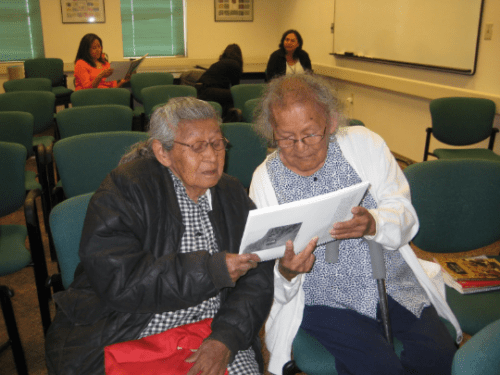
Vivian on left, age 79
Jar 2012-09 is a miniature jar, but it represents a story of enormous hardship, loyalty, and love.

